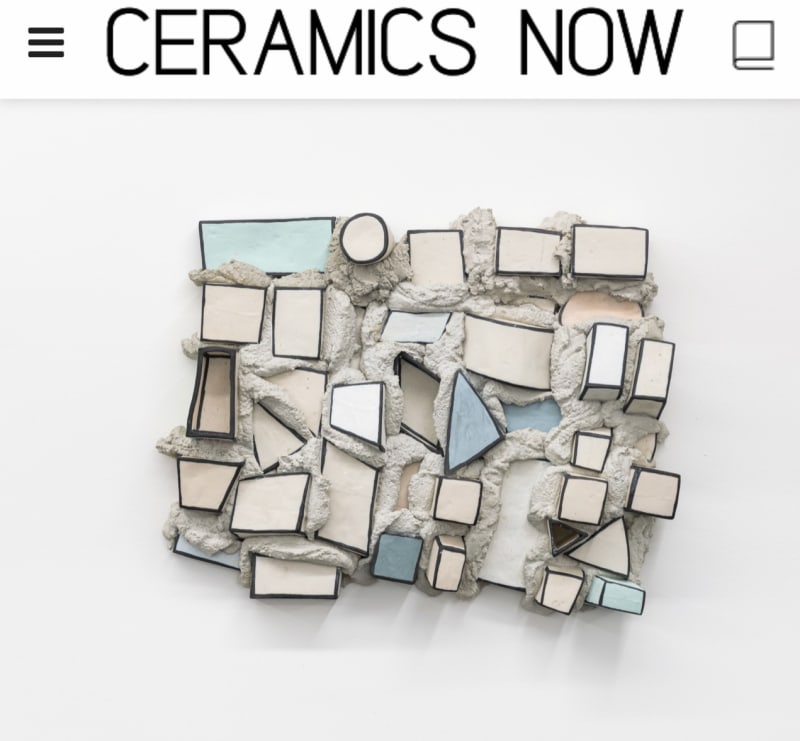Fawn Krieger’s recent series of sculptural works are inherently modular; their bounds are only limited by the decision to pause and ultimately stop. The nebulous structures seem to expand endlessly in multiple directions. Despite this organic fluidity and perceived extension, these sculptures are equivocal and ruminative in Rebus Principle at SE Cooper Contemporary in Portland, Oregon, and Mouth of the Cave at HESSE FLATOW in New York City. Recent ceramic and concrete wall sculptures propose deeper consideration of one of civilization’s defining factors: written language.
Although creating abstract references to language, Krieger returns to the basics in image, pattern, and form. This series of sculptures is titled with a caesura: double oblique lines that are both a visual symbol and a word, denoting a pause in language or a break in spoken verse. A number then indicates the creation sequence, reminiscent of reading music, with percussive stops and melodic interludes. Krieger finds significance in the duality within caesurae, providing space in function and form while also a bridge, linking and delineating the singular and the collective.
In Caesura, Krieger builds on her history of creating works that “examine themes of touch, agency, and transmission,” concepts explored in Rebus Principle and Mouth of the Cave. Despite being similarly made with slip-cast geometric clay shapes and pigmented concrete, the new work shifts to themes of fusion, convergence, and entanglement in contrast to concerns highlighted in her previous work, notably Experiments in Resistance, a series she made during the Trump years. These themes are apparent in all sculptures but //16, //31, and //2 and are prime examples of this new exploration, focused on merging and intersection instead of dislocation and disbandment. This body of new work continues to make observations about language, civilization, and histories, both personal and universal.
Once the concrete is mixed, Krieger has a limited time to nestle ceramic triangles, rhombuses, parallelograms, orbs, semicircles, and rectangles together. A dialogue between the concrete and clay forms. In conversation with gallerist Derek Franklin, he tells me Krieger captures the performative aspect of this process on camera in her studio. These videos have not yet been displayed publicly with her sculptures. But knowing their existence provides an additional dimension and represents Krieger’s interest in challenging assumptions of what is considered art and artifact. The act of recording her process, consequently, interrogates how we construct and perceive the physical records of actions of becoming, hinting at a parallel analogy with the construction of civilization.
Clay has been used for centuries to hold the memory of the physicality of living beings and the environment. Relics from the past have often been ceramically excavated by layers of subsoil and substratum. Are Krieger’s caesura sculptures fossils of the Anthropocene? They investigate modes of reimagining language and communication outside of the written word while also paying homage to the excavation of our past histories. Krieger’s glazing decisions make these visual connections to archaeology – bright red and black checkered with white.
Seen alongside field tools for reference photos on archaeological sites,//9 and //13 exemplify this visual coding, while //14, //10 , //18, all utilize a black and white grid-like structure throughout their linear and fractal sculptural elements. This patterning references tools for measuring and scale, from visual, auditory, and volumetric.
Krieger’s patterning, detail, and color choices inform how the viewer translates these works. Are the sculptures similar to a key, code, or legend to another language? The structure feels vaguely connected to crossword puzzles that encourage multiple approaches and considerations as to what words could fill and intersect with each other. Regardless of the decipherability of the visual language Krieger creates, we follow along, offering our interpretations based on visual clues like hue and structure. Not all of Krieger’s underglaze treatments reference archaeological field tools. She negotiates meaning through pressure, form, and surface. Her polka-dotted, gridded, checkered, and brushy patterns create unique visual lexicons that form unexpected gatherings or families of like-minded vessels, camouflaging themselves into small continents that we call her sculptures.
The concept of caesurae seems relevant to the cadence of recent social-political and global events, particularly post-Trump, and the election of Biden amid a worldwide pandemic. There have been many pauses, despite the twenty-four-seven news cycle. These breaks inspire hope in that they allow processing in the particular epoch, one laden with digital distractions and the constant of connectivity. The pulse of information can be irreverent; lulls in this constant inundation encourage contemplation. The Rebus Principle (the title of Krieger’s exhibition at SE Cooper Contemporary) is built on the phenomenon that a grouping of pictures and sounds converge to form a word or sentence. Krieger’s three-dimensional forms act as the rebus, peeling down the basics of how language was initially created from images. Why not a collection of objects over images? What can Krieger’s work tell us that exists beyond words?
Rebus Principle was on view at SE Cooper Contemporary in Portland, Oregon, from October 30 to December 5, 2021.
Mouth of the Cave at HESSE FLATOW is on view in New York City, New York, from February 18 to March 19, 2022.

